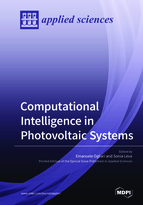Computational Intelligence in Photovoltaic Systems
A special issue of Applied Sciences (ISSN 2076-3417). This special issue belongs to the section "Energy Science and Technology".
Deadline for manuscript submissions: closed (30 November 2018) | Viewed by 58787
Special Issue Editors
Interests: photovoltaics; PV power forecasting; machine learning
Special Issues, Collections and Topics in MDPI journals
Interests: photovoltaic system; grid; power sharing; inverters; forecasting; nowcasting; machine learning; degradation; battery management systems; polymer solar cells; organic photovoltaics; electric vehicle; vehicle-to-grid; microgrid; energy systems; maximum power point trackers; electric power plant loads; electricity price; power markets; heterogeneous networks; base stations; energy efficiency; life cycle assessment; wind power; regenerative braking; bicycles; motorcycles; car sharing; autonomous vehicles
Special Issues, Collections and Topics in MDPI journals
Special Issue Information
Dear Colleagues,
Photovoltaics, among Renewable Energy Sources, has become more popular. However, in recent years, many research topics arose, mainly due to problems that are constantly faced in smart-grid and microgrid operations, output power plants production forecast, storage sizing, modelling, and control optimization of photovoltaic systems.
Computational Intelligence algorithms (evolutionary optimization, neural networks, fuzzy logic, etc.) have become more and more popular as alternative approaches to conventional techniques in solving problems such as modelling, identification, optimization, availability prediction, forecasting, sizing and control of stand-alone, grid-connected, and hybrid photovoltaic systems.
Applied Sciences is an international journal that is developing a Special Issue focused on the latest scientific results and methods belonging to both Computational Intelligence and optimization techniques in all possible photovoltaic applications. Therefore, our goal is to bring together scientists representing several approaches and various research communities working on these topics, with the aim to share as much as possible of top-level research and to promote research on the same advanced topics.
This Special Issue "Computational Intelligence in Photovoltaic Systems" is open to both original research articles and review articles covering all the relevant progress in these fields (though is not limited to the following):
- forecasting techniques (deterministic, stochastic, etc.)
- DC/AC converter control and maximum power point tracking techniques
- sizing of the photovoltaic system components and their optimization
- photovoltaics modelling and parameters estimation
- maintenance and reliability modelling
- decision process for grid operators
Prof. Dr. Sonia Leva
Dr. Emanuele Giovanni Carlo Ogliari
Guest Editors
Manuscript Submission Information
Manuscripts should be submitted online at www.mdpi.com by registering and logging in to this website. Once you are registered, click here to go to the submission form. Manuscripts can be submitted until the deadline. All submissions that pass pre-check are peer-reviewed. Accepted papers will be published continuously in the journal (as soon as accepted) and will be listed together on the special issue website. Research articles, review articles as well as short communications are invited. For planned papers, a title and short abstract (about 100 words) can be sent to the Editorial Office for announcement on this website.
Submitted manuscripts should not have been published previously, nor be under consideration for publication elsewhere (except conference proceedings papers). All manuscripts are thoroughly refereed through a single-blind peer-review process. A guide for authors and other relevant information for submission of manuscripts is available on the Instructions for Authors page. Applied Sciences is an international peer-reviewed open access semimonthly journal published by MDPI.
Please visit the Instructions for Authors page before submitting a manuscript. The Article Processing Charge (APC) for publication in this open access journal is 2400 CHF (Swiss Francs). Submitted papers should be well formatted and use good English. Authors may use MDPI's English editing service prior to publication or during author revisions.
Keywords
- Computational Intelligence
- Photovoltaics Systems
- Modelling and Optimization
- Control
- Evolutionary Optimization
- Artificial Neural Network
- Fuzzy Logic
- Renewable Energy Forecast







